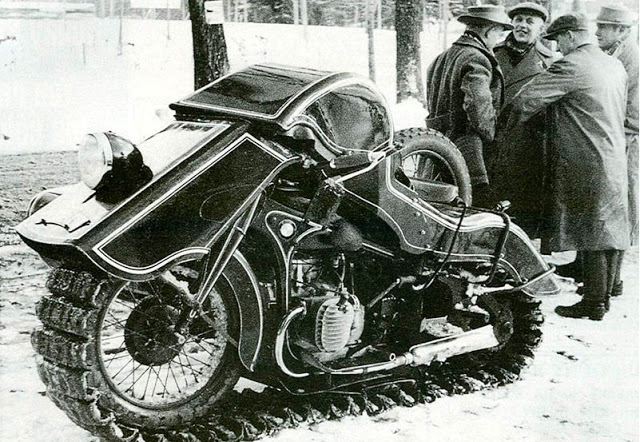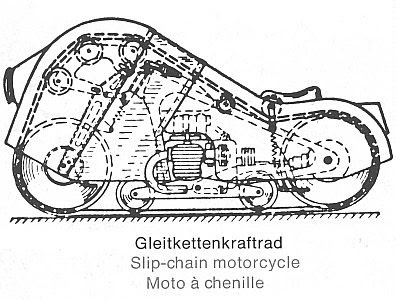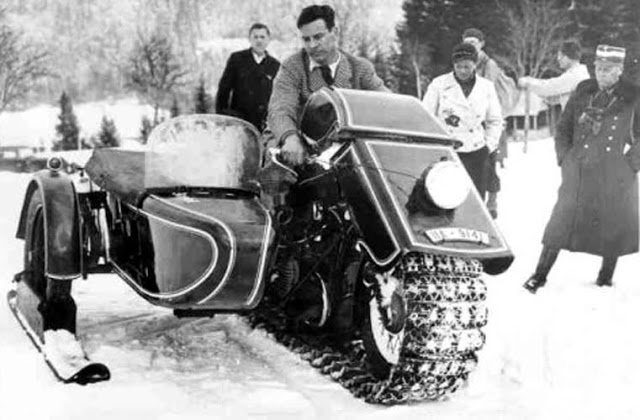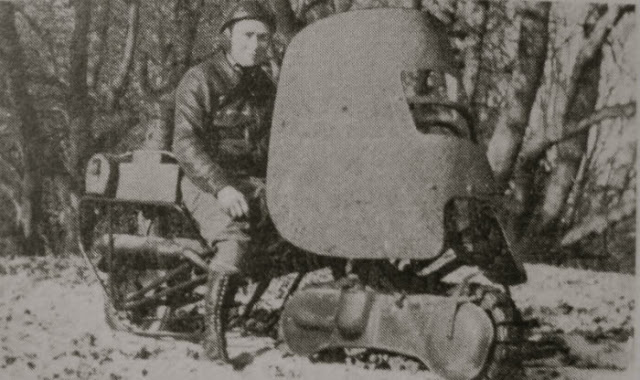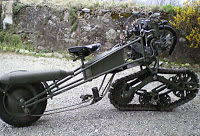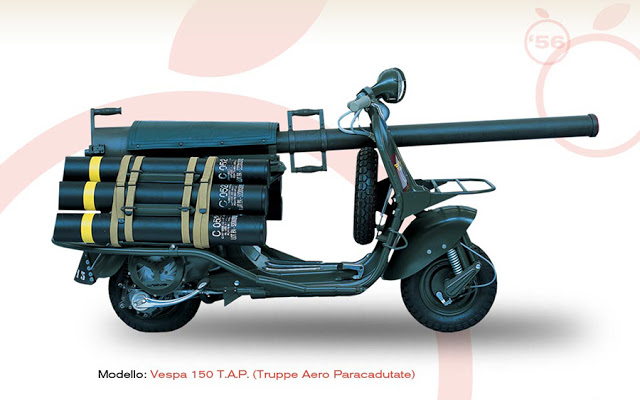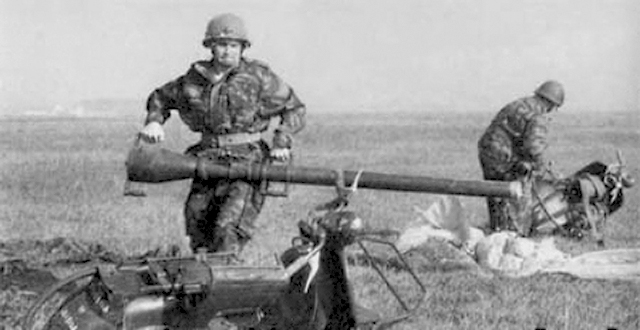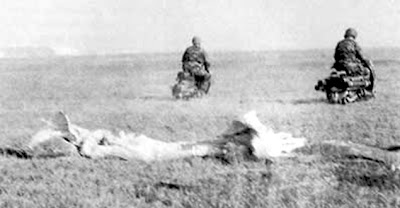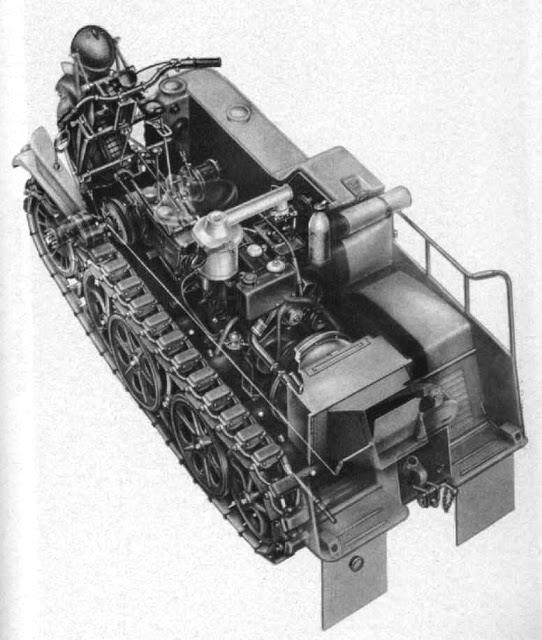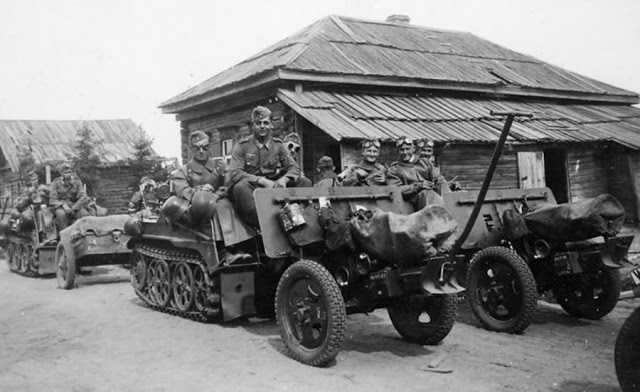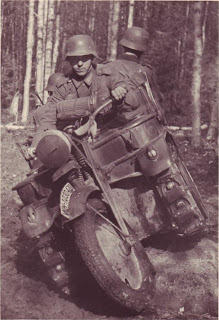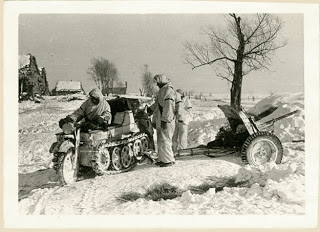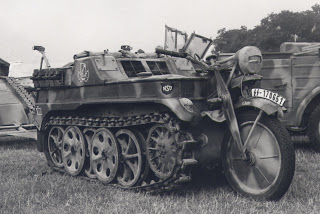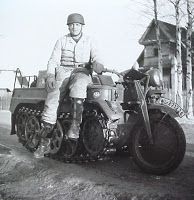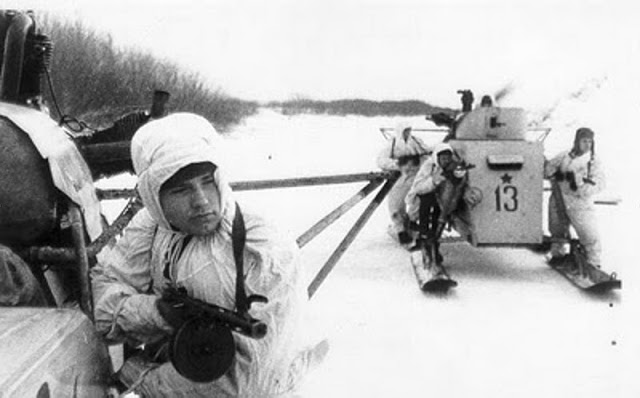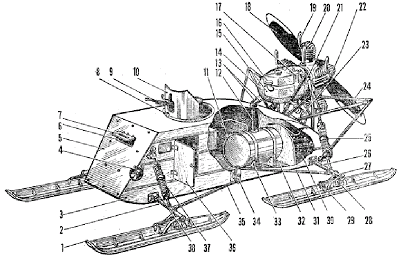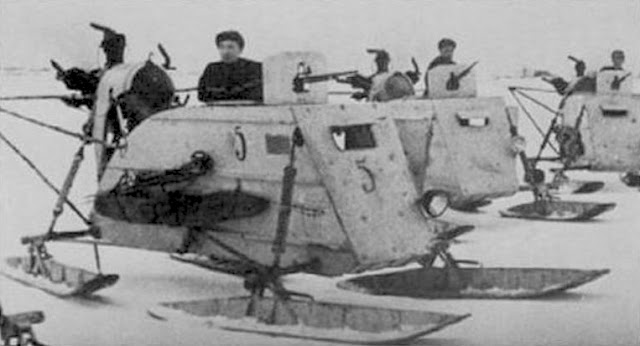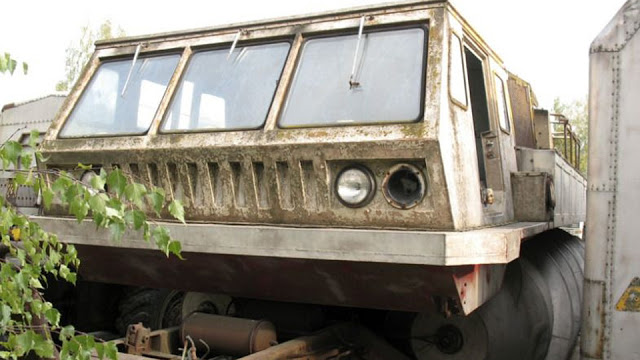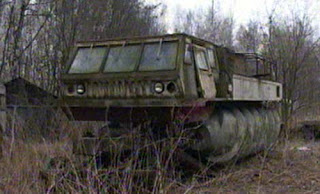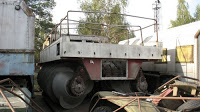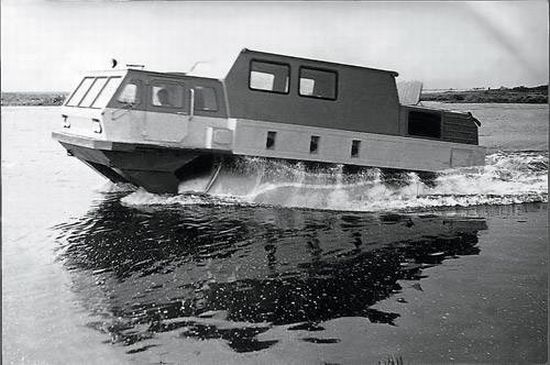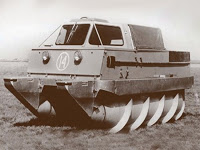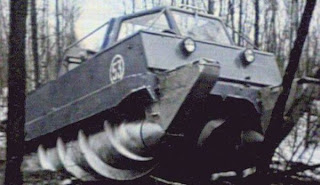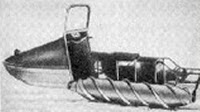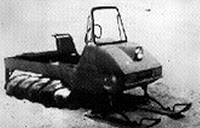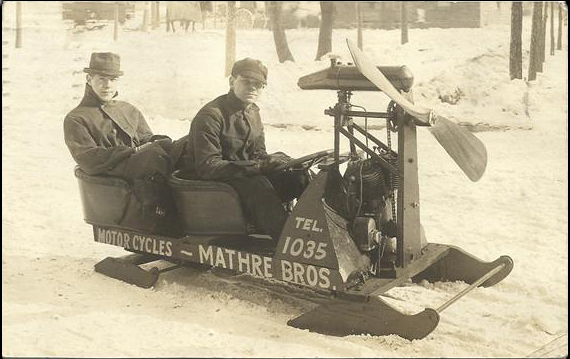Some time back a friend of mine posted a strange photo on my Facebook page; a track-mounted BMW sidecar machine that was so mechanically bizarre that my first comment was “Photoshop”. That comment was premature: further digging showed that it was indeed an actual machine, the BMW Schneekrad.
I was already familiar with the Kettenkrad of course, but this thing seemed to be so far into the realms of “concept bike” that I started wondering what else had come out of the design labs…
The “Schneekrad” prototype snow machine was built in either 1936 or 1939 by BMW engineer Riemerschmidt, using a BMW R-12 engine in a “Gleitkettenkraftrad” or “slip-chain” (?) motorcycle design and a Steib TR-500 sidecar. There is almost no further information on the machine that I can find, which leads me to believe it was a hastily abandoned project with perhaps only a single prototype built.
The diagram appears to be completely infeasible unless there are two separate tracks with the operator mounted between them: yet the photos appear to show a single track which runs beneath the rider and fuel tank. Most likely Riemerschmidt was simply experimenting with the design using whatever pieces were at hand rather than demonstrating a finished prototype, but if anyone has more information on this oddity please let me know.
Tracked motorcycles were neither new nor unique to BMW of course; the British Osborn Engineering Co. (Gosport, Hants) prototyped a tracked motorcycle as early as 1928 and Victoria-Werke AG. experimented with an inline design (replacing the rear wheel with a track) 3 seater in the 1930’s as well.
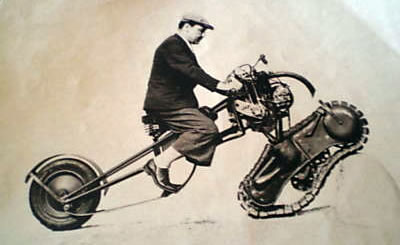 |
| 1937 Mercier Type 3 Tracked Motorcycle |
On February 9, 1937 the French Army tested a “Type 3” tracked motorcycle designed by Adrien Mercier, a Swiss citizen living in Bois-Colombes. The machine used a front mounted J.A. Prestwich 350cc, 11hp. engine with a 3 speed transmission; according to most sources only 3 prototypes were built, but it seems there may have been more as one was actually sold on E-Bay as recently as 2009.
In fact the French were quite serious about their combat motorcycles, and came up with several intimidating designs. Another notable vehicle was the Vespa 150 TAP (Truppe Aero Paracadutate), the familiar Italian scooter (in this case produced under license in France) modified to transport a U.S. made M20 75 mm. recoilless rifle. The recoil in this particular cannon is counteracted by a rear gas venting system which eliminated the need for mechanical recoil suppression or heavy mounts, and technically enabled it to be fired from the lightweight Vespa frame.
While the mental image of an offensive line made up of French bazooka mounted scooters is enough to cause any likely opposing force to immediately retreat in fear of losing their sanity, the reality is that the M20 doesn’t include an aiming device.
In fact the plan was for the scooters to be parachute-dropped in pairs accompanied by a two-man team; the gun was carried on one scooter while the ammunition and a tripod were loaded on the other, and the Vespas were simply meant to be a cheap, lightweight transport rather than an actual firing platform. Approximately 800 of these scooters were deployed in the Algerian War during the late 1950’s.
Of course the best known (and probably most successful) attempt at a tracked motorcycle design was the famous Kleines Kettenkrad HK 101 (SdKfz 2), a half-track vehicle with a motorcycle front end which NSU produced for the Wehrmacht from 1940 to 1945.
Designed by Praxl Ewald and Ernst Schmidt, the Kettenkrad basically consists of a self-supporting sheet steel tub with dual caterpillar drives. The centrally mounted, water cooled, four cylinder in-line OHV engine was manufactured by Opel and produced 36 bhp at 3400 rpm: top speed was 70 km/h (44mph).
The driver sits on a standard motorcycle saddle mounted above the forward gearbox and two rear facing passenger seats were installed behind the engine, although this proved to be somewhat of a disadvantage in combat situations as the passengers had no emergency access to the steering. The steering itself is unique in that the front motorcycle wheel was generally used for light turns but a sharper turn actually engaged the track brakes to turn like a traditional tank. In fact it was recommended to remove the front wheel altogether in especially heavy terrain.
The Kettenkrad proved an effective off-road and general utility vehicle despite the fact that it was relatively expensive to produce and maintain (the tracks alone have 80 lubrication points which need to be greased every 500 miles), and they saw extensive service especially in the deep mud and snow of the Eastern Front. Around 8800 Kettenkrads were built during the war, with another 550 produced post-war (up to 1951) by NSU for agricultural use.
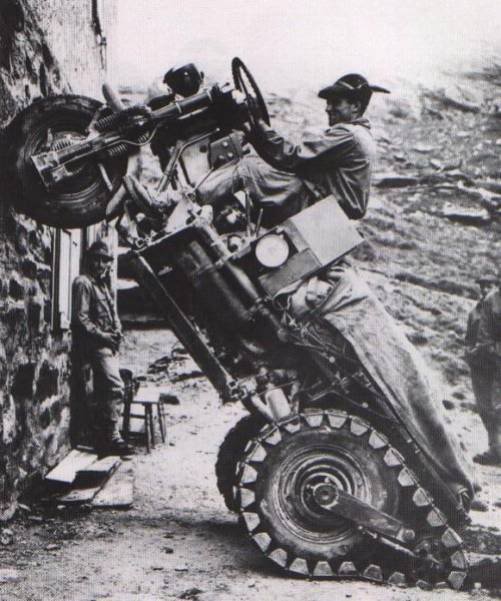 |
| Moto-Guzzi Mulo Meccanico |
The Italians developed a similar vehicle -the “Mulo Meccanico”- in 1960, but unlike the Kettenkrad the Mule was designed more as a three wheeled trike: the tracks are accessories driven by the rear tires. Powered by a Moto-Guzzi 754cc. V-twin, it has 3 wheel drive and a 6 speed gearbox with a max speed of around 50 km/h.
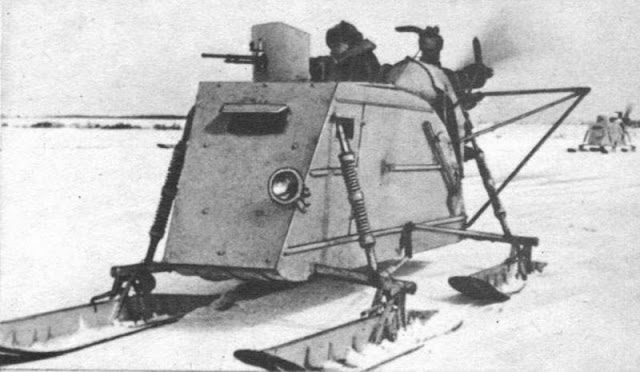 |
| Soviet NKL-26 Aerosani |
Snow of course has always proved a challenge to military vehicles, and various armies have come up with some unique concepts for dealing with it. One of the most visually interesting was the Russian NKL-26 Aerosani; a lightweight plywood box with ten-millimeter armour plate on the front and armed with a 7.62mm DT machine gun in a top mounted ring. It was powered by an M-11G aircraft engine, and could reportedly reach speeds up to 25–35 km/h in deep snow, where most other vehicles couldn’t move at all. Each NKL-26 was operated by two crewmen, and could carry four ski troops riding outside the vehicle on its skis.
An interesting note on the NKL -and one which ties into my old stomping grounds back in Michigan’s U.P.- is that there is some evidence that the Soviets obtained plans for “air sleighs” as early as 1924 from one Chester B. Wing, an aviator, automobile dealer and former mayor of St. Ignace, Michigan, U.S.A. He had built practical aerosleds to run across the ice between St. Ignace and Mackinac Island: the Spring 1943 issue of the magazine Science and Mechanics states that “from his aerosleds the Russians developed their present battle sled”, although that claim has to be viewed in the context of a picture of an Igor Sikorsky machine in Kiev pre-WWI. Multiple designs of the propeller driven snow machine were used during WWII, including a an ASD-400 heavy assault sled.
On the face of it, screw drives were a less than obvious solution to winter mobility but one which was widely experimented with nonetheless. As early as 1907 Ira Peavey of Maine patented a tractor designed for hauling logs with two articulated augers: The prototypes reportedly worked well on hard packed snow but failed in soft powder because the flanges had nothing to grip into. Armstead Co. of Detroit developed the Armstead Snow Motor in the 1920’s, which consisted of two screw cylinders fitted to a Fordson tractor: a promotional film shows the machine hauling 20 tons of logs and it apparently had some production success.
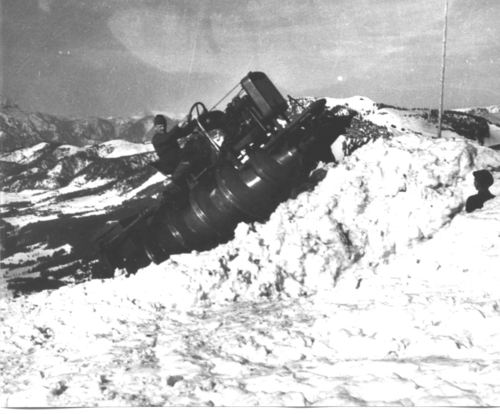 |
| Raedel Schraubenantrieb Schneemaschine, 1944 |
In 1944, Johannes Raedel, a German veteran of the Eastern Front invented the “Schraubenantrieb Schneemaschine” (screw-propelled snow machine) and convinced the OKH in Berlin to allow him to build a prototype. He was dispatched to the Austrian Alpine Vehicle Test Center in Tyrol and presented a working model on April 28, 1944. It was tested extensively, and although very slow it could pull up to one ton and reportedly possessed good climbing capabilities. But it was incapable of penetrating drifts or snow piles, and Raedel’s machine never went into production.
Russia experimented with various screw driven machines, and heavy truck manufacturer ZiL (Zavod imeni Likhachova) built several models, the most famous of which may be their 1975 amphibious screw propelled ZIL-2906, designed specifically for recovering cosmonauts who landed in inaccessible areas. This machine used two Venyukovsky 2103 engines with each driving a separate worm conveyor: steering was accomplished by reversing one screw while locking the other.
 |
| 1969 Navy RUC |
Around the same time the American Waterways Experiment Station tested a “Marsh Screw Amphibian” designed by Chrysler. The counter rotating screws “…propelled the vehicle through water and marsh terrain adequately, but failed miserably on soil surfaces, especially sand”. The average max speed was a meager 1.6 miles per hour, but despite this Chrysler went on to produce a much larger “Riverine Utility Craft” (RUC) for the Navy in 1969. The RUC travelled on two 39 inch (991 mm) diameter aluminum rotors and achieved impressive speeds of 15.7 knots (29.1 km/h) on water and nearly 25 knots (46 km/h) on marsh. But speeds on firm soils still proved disappointing and the vehicle would get stuck crossing dykes; the same problem Raedel faced.
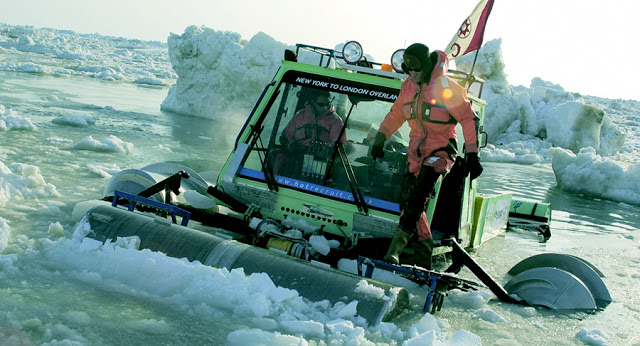 |
| “Ice Challenger” Snowbird 6 |
In 2002 the British “Ice Challenger” expedition used an amphibious screw vehicle known as the Snowbird 6 to cross the Bering Strait: although the expedition was ultimately unsuccessful due to Russian politics, the vehicle performed well and they managed to overcome the inherent difficulty of climbing banks by installing a system to raise the cylinders exposing conventional caterpillar tracks.
There’s plenty of other weirdness out there of course, and as long as mankind is able they’ll certainly continue to attempt reinventing the wheel. And cheers to them. I can’t help but wish many of these prototype machines had proven more successful; no matter how cool your Polaris “Assault” is, that ’36 Schneekrad is WAY cooler.
References:

